The CM SAF TOA Radiation Data Record Using MVIRI and SEVIRI
Abstract
:1. Introduction
2. Input Data
2.1. MVIRI Level 1.5 Data
2.2. SEVIRI Level 1.5 Data
3. Summary of Users’ Requirements
4. Processing
4.1. Visible Clear-Sky Processing
4.2. Data Preprocessing
4.3. TOA Fluxes Processing
- (R.1)
- (R.2)
- Over surfaces with persistent snow cover, no CERES SW TRMM ADM is provided due to very limited observations. The bright desert ADMs are used instead since they are the closest models in terms of albedo.
- (R.3)
- Over shadowed regions (i.e., where the observed reflectance is below the clear-sky reflectance) a simple lambertian model is used.
- (R.4)
- In the sun glint region (corresponding to a Sun Glint Angle lower than 25) over clear ocean surfaces, the flux is estimated from the modeled BB albedo instead of the measured radiance which is strongly affected by specular reflection.
- (R.5)
- For SZA above 85, the CERES twilight model [31] is applied.
4.4. Daily and Monthly Averaging
5. Evaluation Methodology
- the absolute calibration error affecting the temporal radiometric stability of the data record, mainly due to switches of instruments and instrumental drift,
- the accuracy error resulting from the processing of the MVIRI and SEVIRI observations into TOA fluxes,
- the impact of missing input data on the final products, respectively due to missing instantaneous images in the daily averaging or due to missing days in the monthly averaging.
6. Evaluation of TRS Products
6.1. Radiometric Stability of TRS Products
6.1.1. Monthly Mean Products
6.1.2. Daily Mean Products
6.1.3. Monthly Mean Diurnal Cycle Products
6.1.4. TRS Stability According to the Scene Type
6.2. Accuracy of TRS Products
6.2.1. Monthly Mean Products
6.2.2. Daily Mean Products
6.2.3. Monthly Mean Diurnal Cycle Products
6.3. Discussion of TRS Stability, Accuracy and Absolute Level
7. Evaluation of TET Products
7.1. Radiometric Stability of TET Products
7.1.1. Monthly Mean Products
7.1.2. Daily Mean Products
7.1.3. Monthly Mean Diurnal Cycle Products
7.1.4. TET Stability According to the Scene Type
7.2. Accuracy of TET Products
7.2.1. Monthly Mean Products
7.2.2. Daily Mean Products
7.2.3. Monthly Mean Diurnal Cycle Products
7.3. Discussion of TET Stability, Accuracy and Absolute Level
8. Summary of the Errors
- (R.1)
- The reported additional uncertainty due to missing data does not affect the products without missing data.
- (R.2)
- The missing data uncertainty must be added to the processing error.
- (R.3)
- The reported errors for the TRS MMDC products are estimated for the time intervals with the highest illumination of the Meteosat FOV (i.e., 11 and 12 UTC).
- (R.4)
- These months are January, February and March 1987 and have been discarded from the released data record.
9. Calibration Uncertainty
10. Conclusions
Acknowledgments
Author Contributions
Conflicts of Interest
Abbreviations
| ADM | Angular Dependency Model |
| AVHRR | Advanced Very High Resolution Radiometer |
| BB | Broadband |
| CDR | Climate Data Record |
| CERES | Clouds and the Earth’s Radiant Energy System |
| CM SAF | Satellite Application Facility on Climate Monitoring |
| CS | Clear-Sky |
| DM | Daily Mean |
| EBAF | Energy Balanced And Filled |
| ECMWF | European Center for Medium Range Forecast |
| ERB | Earth Radiation Budget |
| EUMETSAT | European Organization for the Exploitation of Meteorological Satellites |
| FOV | Field Of View |
| GERB | Geostationary Earth Radiation Budget |
| GSICS | Global Space-based Inter-Calibration System |
| HIRS | High-resolution Infrared Radiation Sounder |
| IR | Infrared |
| ISCCP | International Satellite Cloud Climatology Project |
| KNMI | Koninklijk Nederlands Meteorologisch Instituut |
| LW | Longwave |
| MFG | Meteosat First Generation |
| MM | Monthly Mean |
| MMDC | Monthly Mean Diurnal Cycle |
| MSG | Meteosat Second Generation |
| MVIRI | Meteosat Visible and InfraRed Imager |
| NB | Narrowband |
| NetCDF | Network Common Data Form |
| OLR | Outgoing Longwave Radiation |
| RMS | Root Mean Square |
| SBDART | Santa Barbara DISORT Atmospheric Radiative Transfer model |
| SEVIRI | Spinning Enhanced Visible and InfraRed Imager |
| SW | Shortwave |
| SZA | Solar Zenith Angle |
| TET | Top Of the Atmosphere Emitted Thermal |
| TIS | Top Of the Atmosphere Incoming Solar |
| TOA | Top Of the Atmosphere |
| TRMM | Tropical Rainfall Measurement Mission |
| TRS | Top of the Atmosphere Reflected Solar |
| UTC | Coordinated Universal Time |
| VIS | Visible |
| VZA | Viewing Zenith Angle |
| WV | Water Vapor |
References
- Harries, J.E.; Russell, J.E.; Hanafin, J.A.; Brindley, H.; Futyan, J.; Rufus, J.; Kellock, S.; Matthews, G.; Wrigley, R.; Last, A.; et al. The geostationary earth radiation budget project. Bull. Am. Meteorol. Soc. 2005, 86, 945. [Google Scholar] [CrossRef]
- Dewitte, S.; Gonzalez, L.; Clerbaux, N.; Ipe, A.; Bertrand, C.; De Paepe, B. The geostationary earth radiation budget edition 1 data processing algorithms. Adv. Space Res. 2008, 41, 1906–1913. [Google Scholar] [CrossRef]
- Müller, R.; Pfeifroth, U.; Träger-Chatterjee, C.; Cremer, R.; Trentmann, J.; Hollmann, R. Surface Solar Radiation Data Set—Heliosat (SARAH), 1st ed.; Climate Monitoring Satellite Application Facility: Darmstadt, Germany, 2015. [Google Scholar]
- Karlsson, K.G.; Anttila, K.; Trentmann, J.; Stengel, M.; Meirink, J.F.; Devasthale, A.; Hanschmann, T.; Kothe, S.; Jääskeläinen, E.; Sedlar, J.; et al. CLARA-A2: CM SAF Cloud, Albedo and Surface Radiation Dataset from AVHRR Data, 2nd ed.; Climate Monitoring Satellite Application Facility: Darmstadt, Germany, 2017. [Google Scholar]
- Duguay-Tetzlaff, A.; Bento, V.A.; Göttsche, F.M.; Stöckli, R.; Martins, J.; Trigo, I.; Olesen, F.; Bojanowski, J.S.; da Camara, C.; Kunz, H. Meteosat land surface temperature climate data record: Achievable accuracy and potential uncertainties. Remote Sens. 2015, 7, 13139–13156. [Google Scholar] [CrossRef]
- Schmetz, J.; Pili, P.; Tjemkes, S.; Just, D. An introduction to Meteosat second generation (MSG). Bull. Am. Meteorol. Soc. 2002, 83, 977. [Google Scholar] [CrossRef]
- Wielicki, B.A.; Priestley, K.; Minnis, P.; Loeb, N.; Kratz, D.; Charlock, T.; Doelling, D.; Young, D. CERES radiation budget accuracy overview. In Proceedings of the 12th Conference on Atmospheric Radiation, Madison, WI, USA, 10–14 July 2006. [Google Scholar]
- CM SAF. Available online: http://www.cmsaf.eu (accessed on 17 February 2017).
- Urbain, M.; Clerbaux, N.; Ipe, A.; Tornow, F. Top of Atmosphere Radiation MVIRI/SEVIRI Data Record; Climate Monitoring Satellite Application Facility: Darmstadt, Germany, 2017. [Google Scholar]
- Clerbaux, N. Requirements Review for the Top of Atmosphere Radiation MVIRI/SEVIRI Data Record, 3rd ed.; Climate Monitoring Satellite Application Facility: Darmstadt, Germany, 2014. [Google Scholar]
- Ipe, A.; Clerbaux, N.; Bertrand, C.; Dewitte, S.; Gonzalez, L. Pixel-scale composite top-of-the-atmosphere clear-sky reflectances for Meteosat-7 visible data. J. Geophys. Res. Atmos. 2003, 108, D19. [Google Scholar] [CrossRef]
- Tornow, F.; Clerbaux, N.; Ipe, A.; Urbain, M. An improved method to estimate reference cloud-free images for the visible band of geostationary satellites. Int. J. Remote Sens. 2016. submitted. [Google Scholar]
- Loeb, N.G.; Manalo-Smith, N.; Kato, S.; Miller, W.F.; Gupta, S.K.; Minnis, P.; Wielicki, B.A. Angular distribution models for top-of-atmosphere radiative flux estimation from the Clouds and the Earth’s Radiant Energy System instrument on the Tropical Rainfall Measuring Mission satellite. Part I: Methodology. J. Appl. Meteorol. 2003, 42, 240–265. [Google Scholar] [CrossRef]
- Rossow, W.B.; Schiffer, R.A. Advances in understanding clouds from ISCCP. Bull. Am. Meteorol. Soc. 1999, 80, 2261–2287. [Google Scholar] [CrossRef]
- Govaerts, Y.M.; Clerici, M.; Clerbaux, N. Operational calibration of the Meteosat radiometer VIS band. IEEE Trans. Geosci. Remote Sens. 2004, 42, 1900–1914. [Google Scholar] [CrossRef]
- Meirink, J.F.; Roebeling, R.A.; Stammes, P. Inter-calibration of polar imager solar channels using SEVIRI. Atmos. Meas. Tech. 2013, 6, 2495–2508. [Google Scholar] [CrossRef]
- Ricchiazzi, P.; Yang, S.; Gautier, C.; Sowle, D. SBDART: A research and teaching software tool for plane-parallel radiative transfer in the Earth’s atmosphere. Bull. Am. Meteorol. Soc. 1998, 79, 2101. [Google Scholar] [CrossRef]
- Govaerts, Y.M. Correction of the Meteosat-5 and-6 radiometer solar channel spectral response with the Meteosat-7 sensor spectral characteristics. Int. J. Remote Sens. 1999, 20, 3677–3682. [Google Scholar] [CrossRef]
- Loveland, T.R.; Reed, B.C.; Brown, J.F.; Ohlen, D.O.; Zhu, Z.; Yang, L.W.M.J.; Merchant, J.W. Development of a global land cover characteristics database and IGBP DISCover from 1 km AVHRR data. Int. J. Remote Sens. 2000, 21, 1303–1330. [Google Scholar] [CrossRef]
- Townshend, J.R.G.; Justice, C.O.; Skole, D.; Malingreau, J.P.; Cihlar, J.; Teillet, P.; Sadowski, F.; Ruttenberg, S. The 1 km resolution global data set: Needs of the International Geosphere Biosphere Programme. Int. J. Remote Sens. 1994, 15, 3417–3441. [Google Scholar] [CrossRef]
- Ipe, A. Cloud Properties Retrieval for Climate Studies from Geostationary Orbit. Ph.D. Thesis, Vrije Universiteit Brusssel, Brusssel, Belgium, 30 June 2011. Available online: http://gerb.oma.be (accessed on 17 February 2017).
- Ipe, A.; Gonzalez, L.; Bertrand, C.; Baudrez, E.; Clerbaux, N.; Decoster, I.; Dewitte, S.; Nevens, S.; Velazquez Blazquez, A. Cloud detection using IR SEVIRI channels for GERB. Remote Sens. Environ. 2010. submitted. [Google Scholar]
- Ipe, A.; Bertrand, C.; Clerbaux, N.; Dewitte, S.; Gonzalez, L. Validation and homogenization of cloud optical depth and cloud fraction retrievals for GERB/SEVIRI scene identification using Meteosat-7 data. Atmos. Res. 2004, 72, 17–37. [Google Scholar] [CrossRef]
- Clerbaux, N. Processing of Geostationary Satellite Observation for Earth Radiation Budget Studies. Ph.D. Thesis, Vrije Universiteit Brusssel, Brusssel, Belgium, 25 November 2008. Available online: http://gerb.oma.be (accessed on 17 February 2017).
- Clerbaux, N.; Dewitte, S.; Bertrand, C.; Caprion, D.; De Paepe, B.; Gonzalez, L.; Ipe, A. GERB-like data from Meteosat First Generation. In Proceedings of the EUMETSAT Meteorological Satellite Conference, Amsterdam, The Netherlands, 24–28 September 2007; p. 48. [Google Scholar]
- Clerbaux, N.; Dewitte, S.; Gonzalez, L.; Bertrand, C.; Nicula, B.; Ipe, A. Outgoing longwave flux estimation: Improvement of angular modelling using spectral information. Remote Sens. Environ. 2003, 85, 389–395. [Google Scholar] [CrossRef]
- Bertrand, C.; Clerbaux, N.; Ipe, A.; Dewitte, S.; Gonzalez, L. Angular distribution models, anisotropic correction factors, and mixed clear-scene types: A sensitivity study. IEEE Trans. Geosci. Remote Sens. 2005, 43, 92–102. [Google Scholar] [CrossRef]
- Suttles, J.T.; Green, R.N.; Minnis, P.; Smith, G.L.; Staylor, W.F.; Wielicki, B.A.; Walker, I.J.; Young, D.F.; Taylor, V.R.; Stowe, L.L. Angular Radiation Models for Earth-Atmosphere System. Volume 1: Shortwave Radiation; NASA Langley Research Center: Hampton, VA, USA, 1988.
- Simmons, A.; Uppala, S.; Dee, D.; Kobayashi, S. ERA-Interim: New ECMWF reanalysis products from 1989 onwards. ECMWF Newsl. 2007, 110, 25–35. [Google Scholar]
- Dee, D.P.; Uppala, S.M.; Simmons, A.J.; Berrisford, P.; Poli, P.; Kobayashi, S.; Andrae, U.; Balmaseda, M.A.; Balsamo, G.; Bauer, P.; et al. The ERA-Interim reanalysis: Configuration and performance of the data assimilation system. Q. J. R. Meteorol. Soc. 2011, 137, 553–597. [Google Scholar] [CrossRef]
- Kato, S.; Loeb, N.G. Twilight irradiance reflected by the earth estimated from Clouds and the Earth’s Radiant Energy System (CERES) measurements. J. Clim. 2003, 16, 2646–2650. [Google Scholar] [CrossRef]
- Clerbaux, N. Algorithm Theoretical Basis Document for the Top of Atmosphere Radiation GERB Datasets, 2nd ed.; Climate Monitoring Satellite Application Facility: Darmstadt, Germany, 2016. [Google Scholar]
- Loeb, N.G.; Wielicki, B.A.; Doelling, D.R.; Smith, G.L.; Keyes, D.F.; Kato, S.; Manalo-Smith, N.; Wong, T. Toward optimal closure of the Earth’s top-of-atmosphere radiation budget. J. Clim. 2009, 22, 748–766. [Google Scholar] [CrossRef]
- Loeb, N.G.; Lyman, J.M.; Johnson, G.C.; Allan, R.P.; Doelling, D.R.; Wong, T.; Soden, B.J.; Stephens, G.L. Observed changes in top-of-the-atmosphere radiation and upper-ocean heating consistent within uncertainty. Nat. Geosci. 2012, 5, 110–113. [Google Scholar] [CrossRef]
- Wielicki, B.A.; Barkstrom, B.R.; Harrison, E.F.; Lee, R.B., III; Louis Smith, G.; Cooper, J.E. Clouds and the Earth’s Radiant Energy System (CERES): An earth observing system experiment. Bull. Am. Meteorol. Soc. 1996, 77, 853–868. [Google Scholar] [CrossRef]
- Doelling, D.R.; Loeb, N.G.; Keyes, D.F.; Nordeen, M.L.; Morstad, D.; Nguyen, C.; Wielicki, B.A.; Young, D.F.; Sun, M. Geostationary enhanced temporal interpolation for CERES flux products. J. Atmos. Ocean. Technol. 2013, 30, 1072–1090. [Google Scholar] [CrossRef]
- Lee, H.T. HIRS Daily OLR Climate Data Record Development and Evaluation. In Proceedings of the CERES Science Team Meeting, NASA LaRC, Hampton, VA, USA, 22–24 April 2014. [Google Scholar]
- Lee, H.T.; Schreck, C.J.; Knapp, K.R. Generation of the Daily OLR Climate Data Record. In Proceedings of the EUMETSAT Meteorological Satellite Conference, Geneva, Switzerland, 22–26 September 2014. [Google Scholar]
- Allan, R.P.; Liu, C.; Loeb, N.G.; Palmer, M.D.; Roberts, M.; Smith, D.; Vidale, P.L. Changes in global net radiative imbalance 1985–2012. Geophys. Res. Lett. 2014, 41, 5588–5597. [Google Scholar] [CrossRef] [PubMed]
- Wong, T.; Wielicki, B.A.; Lee, R.B., III; Smith, G.L.; Bush, K.A.; Willis, J.K. Reexamination of the observed decadal variability of the earth radiation budget using altitude-corrected ERBE/ERBS nonscanner WFOV data. J. Clim. 2006, 19, 4028–4040. [Google Scholar] [CrossRef]
- Minnis, P.; Harrison, E.F.; Stowe, L.L.; Gibson, G.G.; Denn, F.M.; Doelling, D.R.; Smith, W.L. Radiative climate forcing by the Mount Pinatubo eruption. Science 1993, 259, 1411–1415. [Google Scholar] [CrossRef] [PubMed]
- Zhang, Y.; Rossow, W.B.; Lacis, A.A.; Oinas, V.; Mishchenko, M.I. Calculation of radiative fluxes from the surface to top of atmosphere based on ISCCP and other global data sets: Refinements of the radiative transfer model and the input data. J. Geophys. Res. Atmos. 2004, 109. [Google Scholar] [CrossRef]
- Decoster, I.; Clerbaux, N.; Govaerts, Y.M.; Baudrez, E.; Ipe, A.; Dewitte, S.; Nevens, S.; Velazquez Blazquez, A.; Cornelis, J. Evidence of pre-launch characterization problem of Meteosat-7 visible spectral response. Remote Sens. Lett. 2013, 4, 1008–1017. [Google Scholar] [CrossRef]
- Decoster, I.; Clerbaux, N.; Baudrez, E.; Dewitte, S.; Ipe, A.; Nevens, S.; Velazquez Blazquez, A.; Cornelis, J. A Spectral Aging Model for the Meteosat-7 Visible Band. J. Atmos. Ocean. Technol. 2013, 30, 496–509. [Google Scholar] [CrossRef]
- Decoster, I.; Clerbaux, N.; Baudrez, E.; Dewitte, S.; Ipe, A.; Nevens, S.; Velazquez Blazquez, A.; Cornelis, J. Spectral aging model applied to meteosat first generation visible band. Remote Sens. 2014, 6, 2534–2571. [Google Scholar] [CrossRef]
- Decoster, I. Spectral Ageing Model for the Meteosat First Generation Visible Band. Ph.D. Thesis, Vrije Universiteit Brusssel, Brussel, Belgium, 27 January 2014. Available online: http://gerb.oma.be (accessed on 17 February 2017).
- Clerbaux, N.; Russell, J.E.; Dewitte, S.; Bertrand, C.; Caprion, D.; De Paepe, B.; Gonzalez, L.; Ipe, A.; Bantges, R.; Brindley, H.E. Comparison of GERB instantaneous radiance and flux products with CERES Edition-2 data. Remote Sens. Environ. 2009, 113, 102–114. [Google Scholar] [CrossRef]
- Russell, J.E.; Dewitte, S.; Harries, J.E. Quality Summary: GERB L2 ARG: 3 Scan Average Edition 1 Product. 2006. Available online: http://gerb.oma.be (accessed on 17 February 2017).
- Pili, P. Calibration of SEVIRI. In Proceedings of the EUMETSAT Meteorological Satellite Data Users’ Conference, Bologna, Italy, 29 May–2 June 2000; pp. 33–39. [Google Scholar]
- Wang, L.; Cao, C.; Ciren, P. Assessing NOAA-16 HIRS radiance accuracy using simultaneous nadir overpass observations from AIRS. J. Atmos. Ocean. Technol. 2007, 24, 1546–1561. [Google Scholar] [CrossRef]
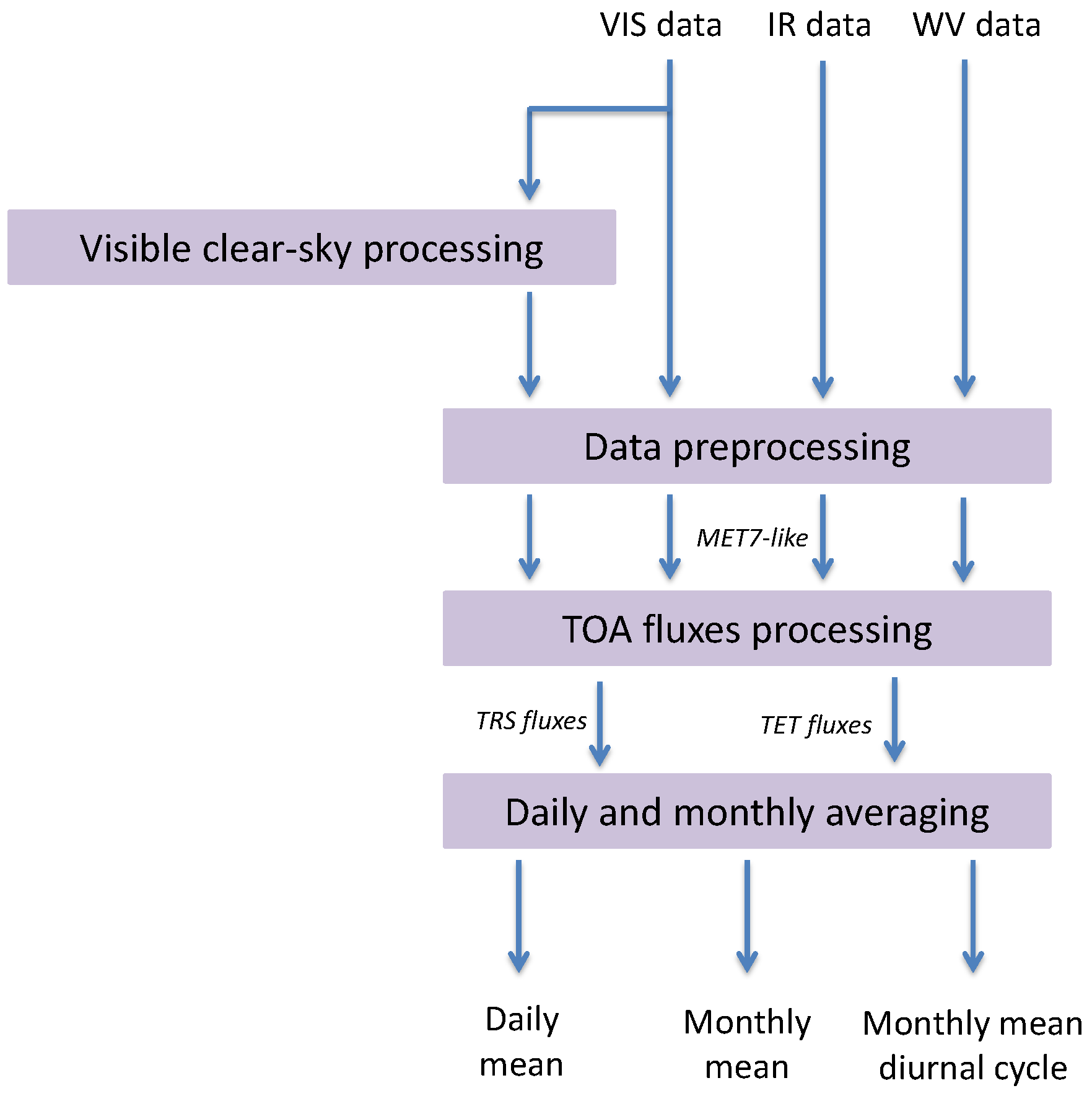

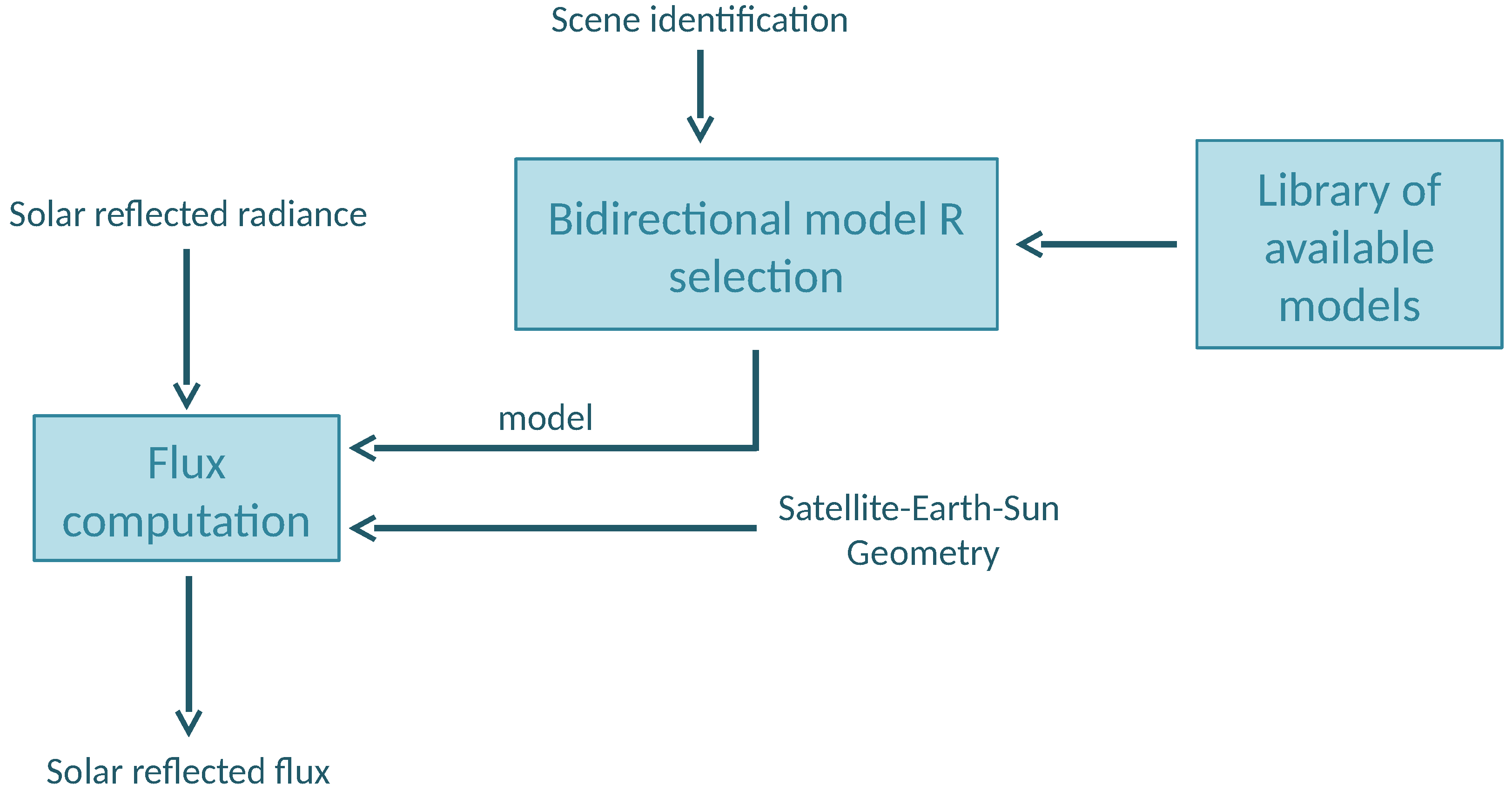
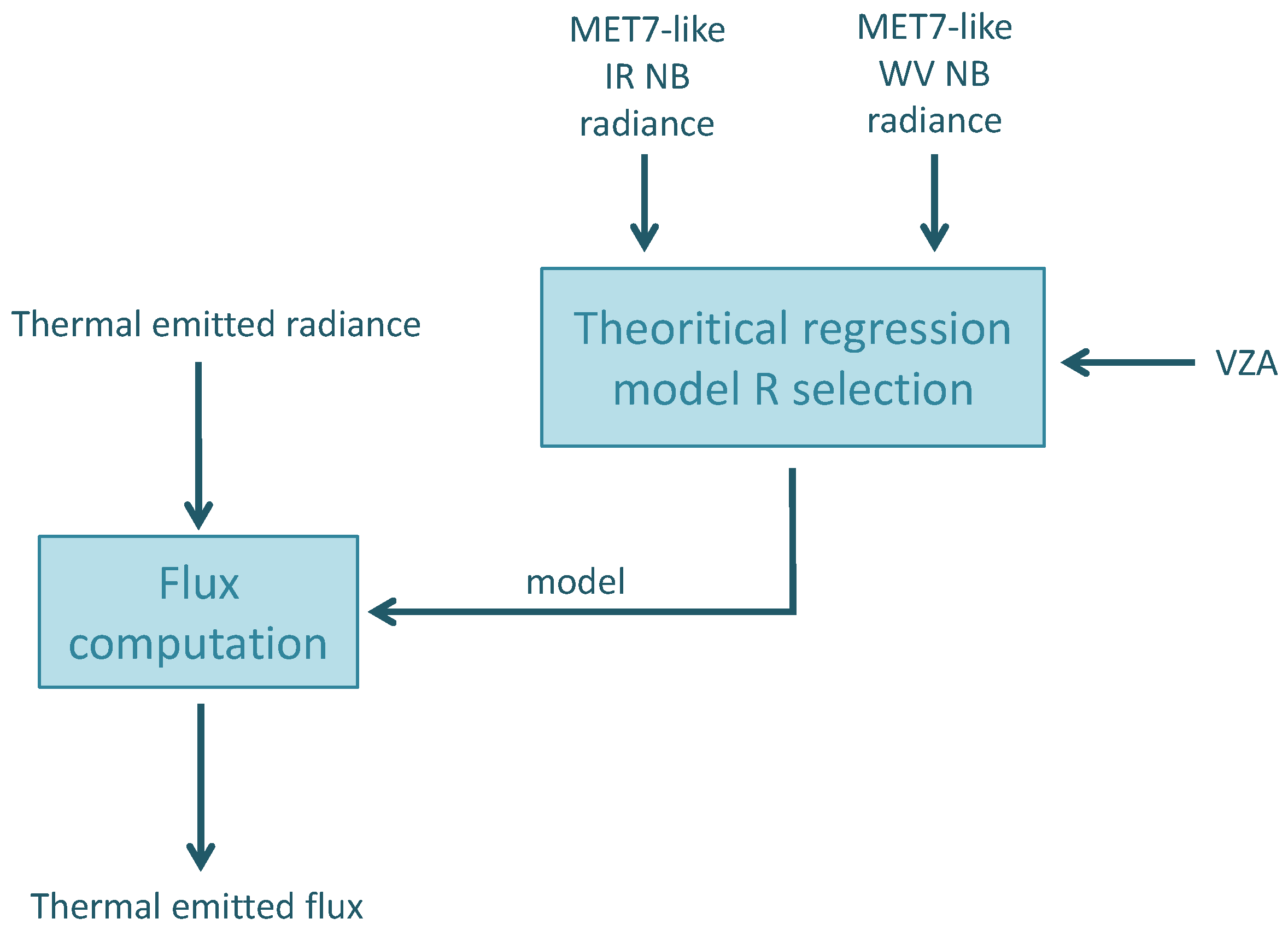
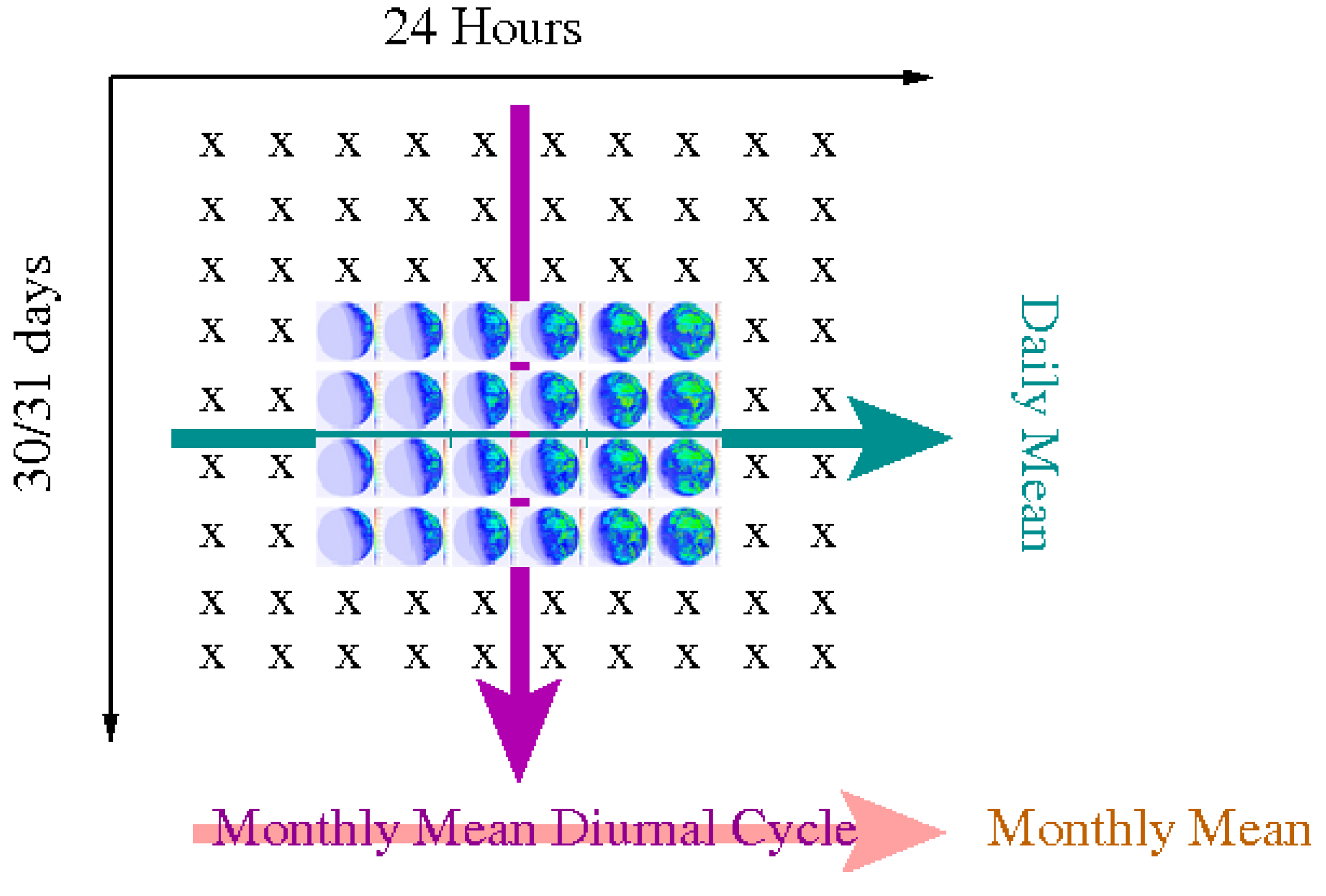
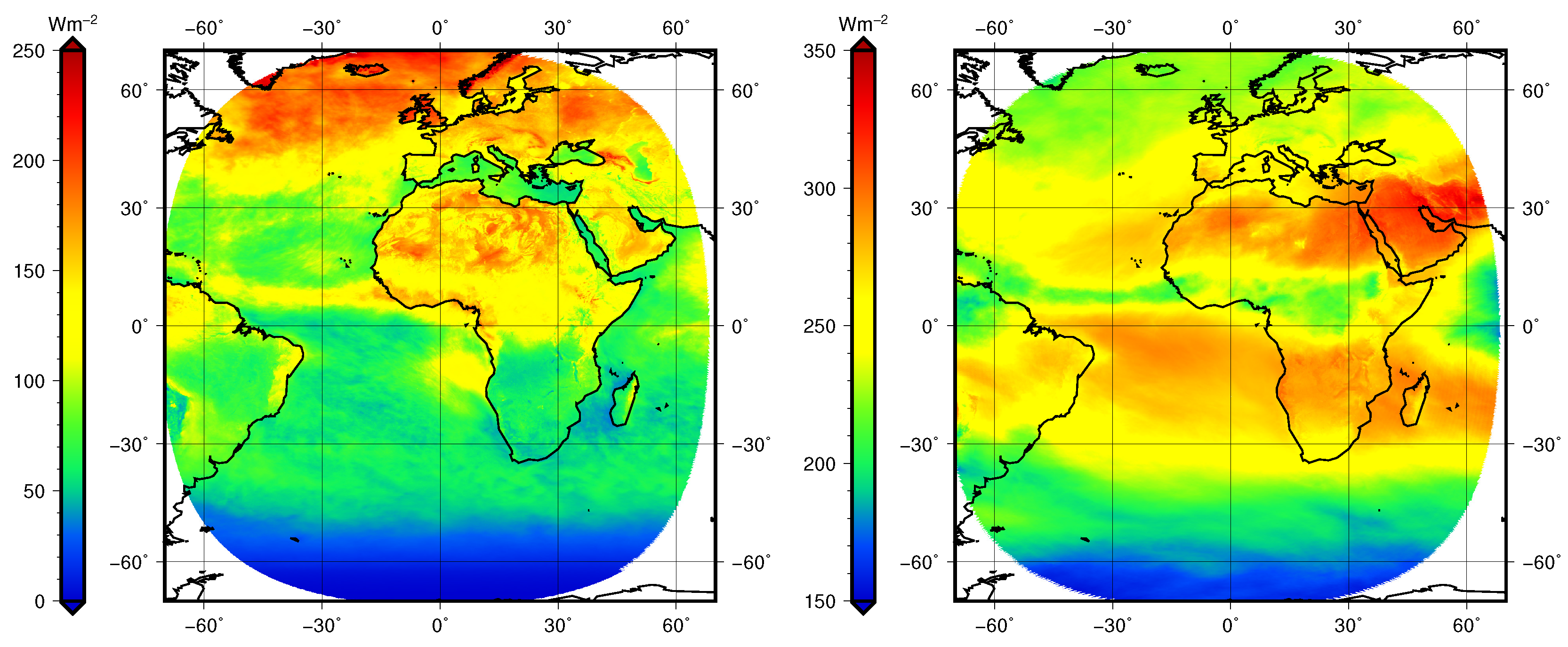


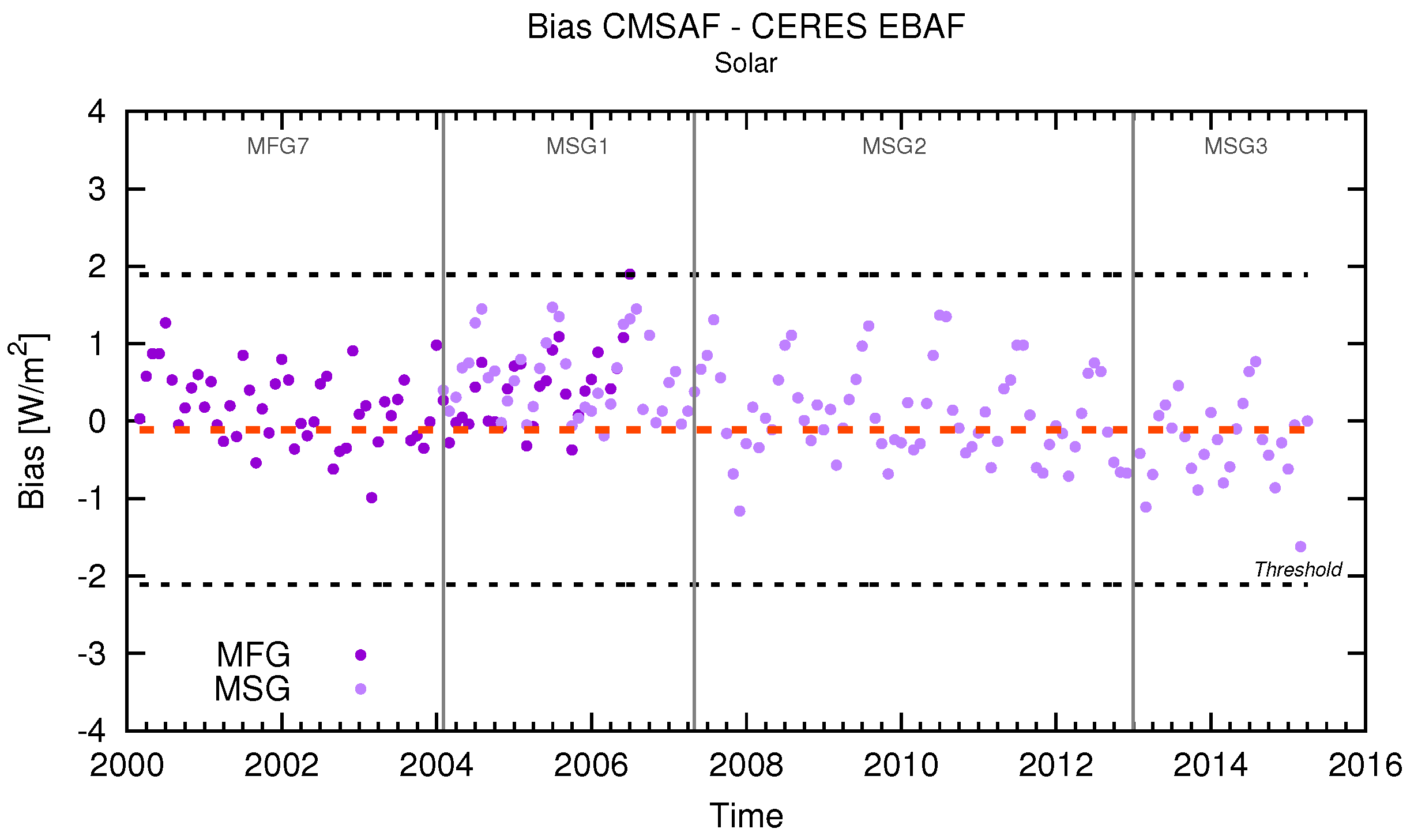
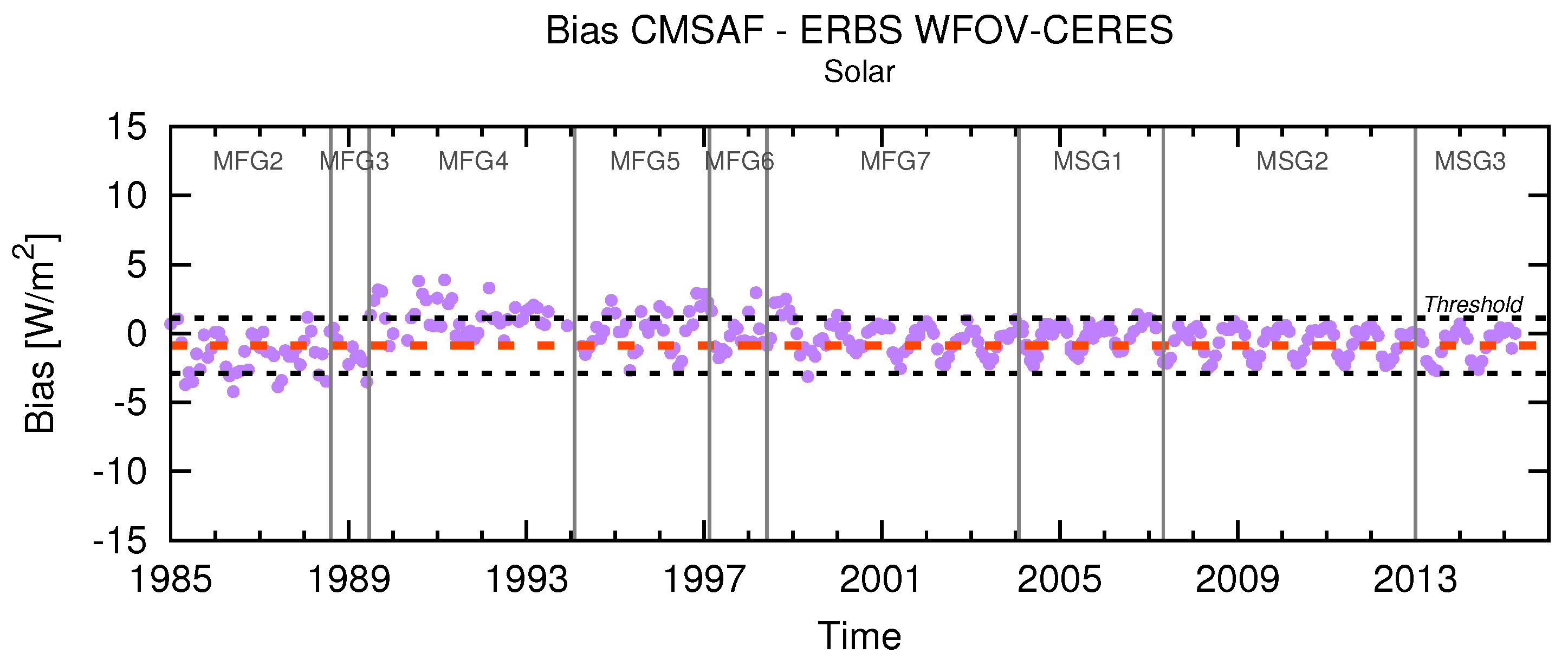


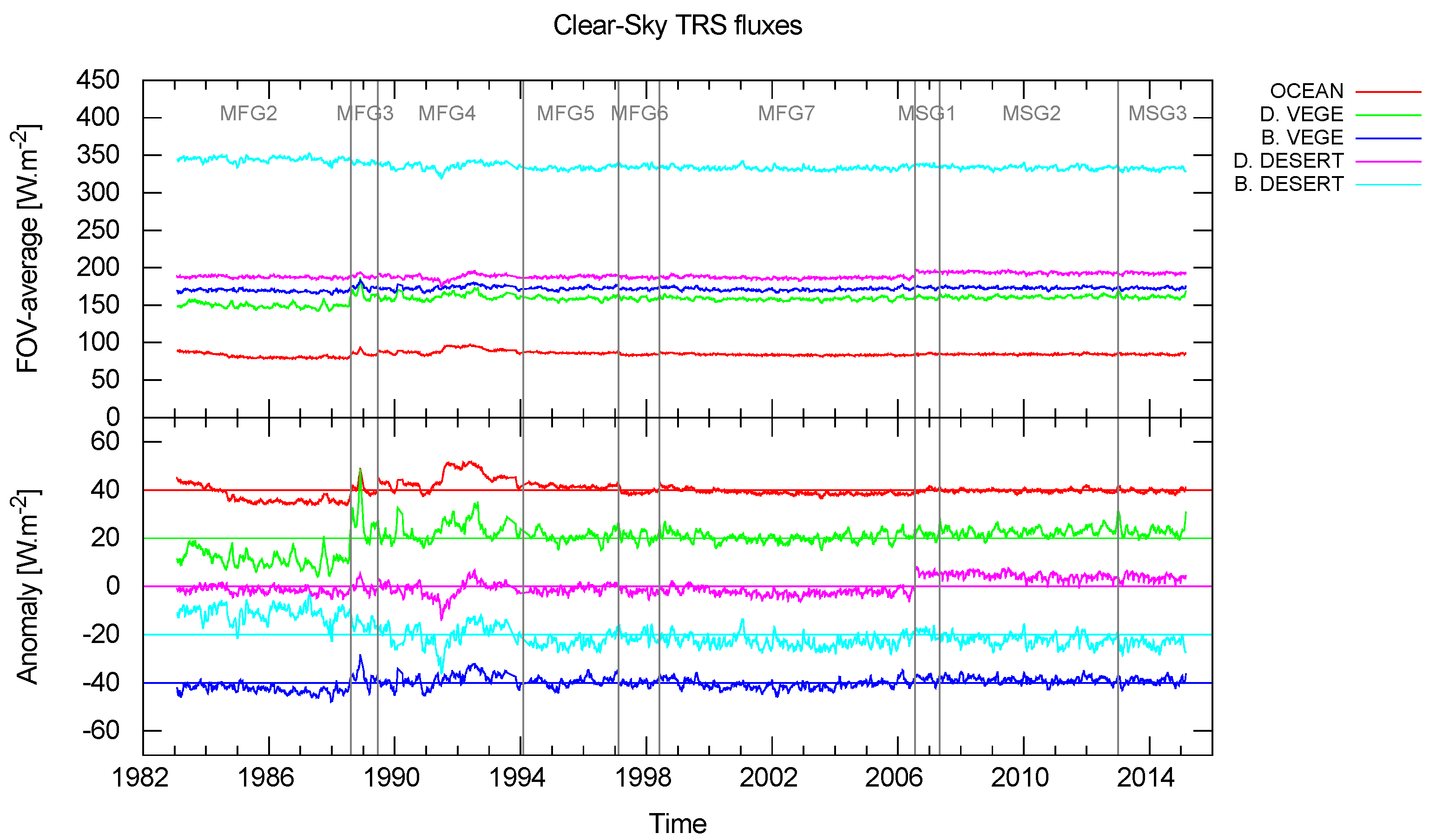



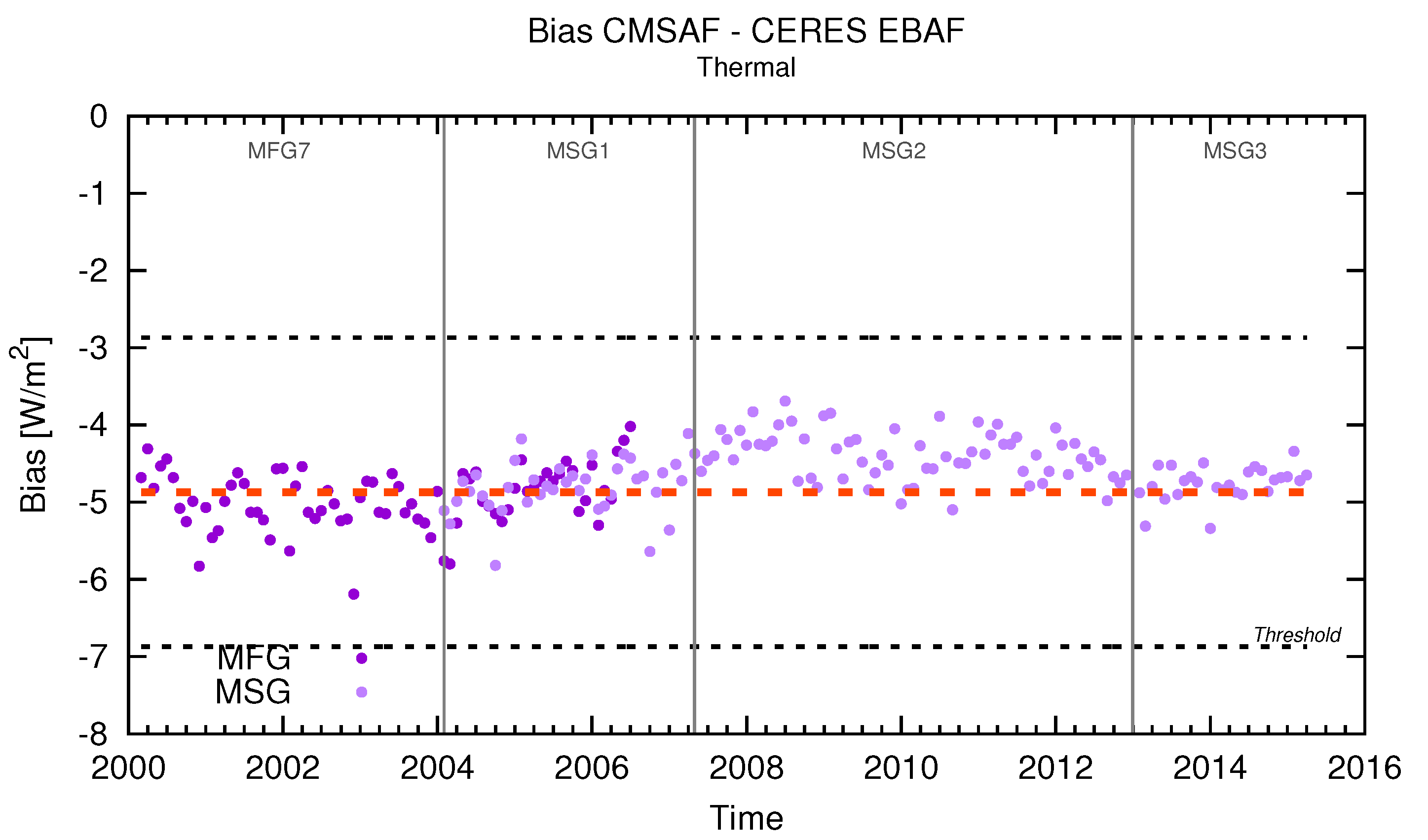
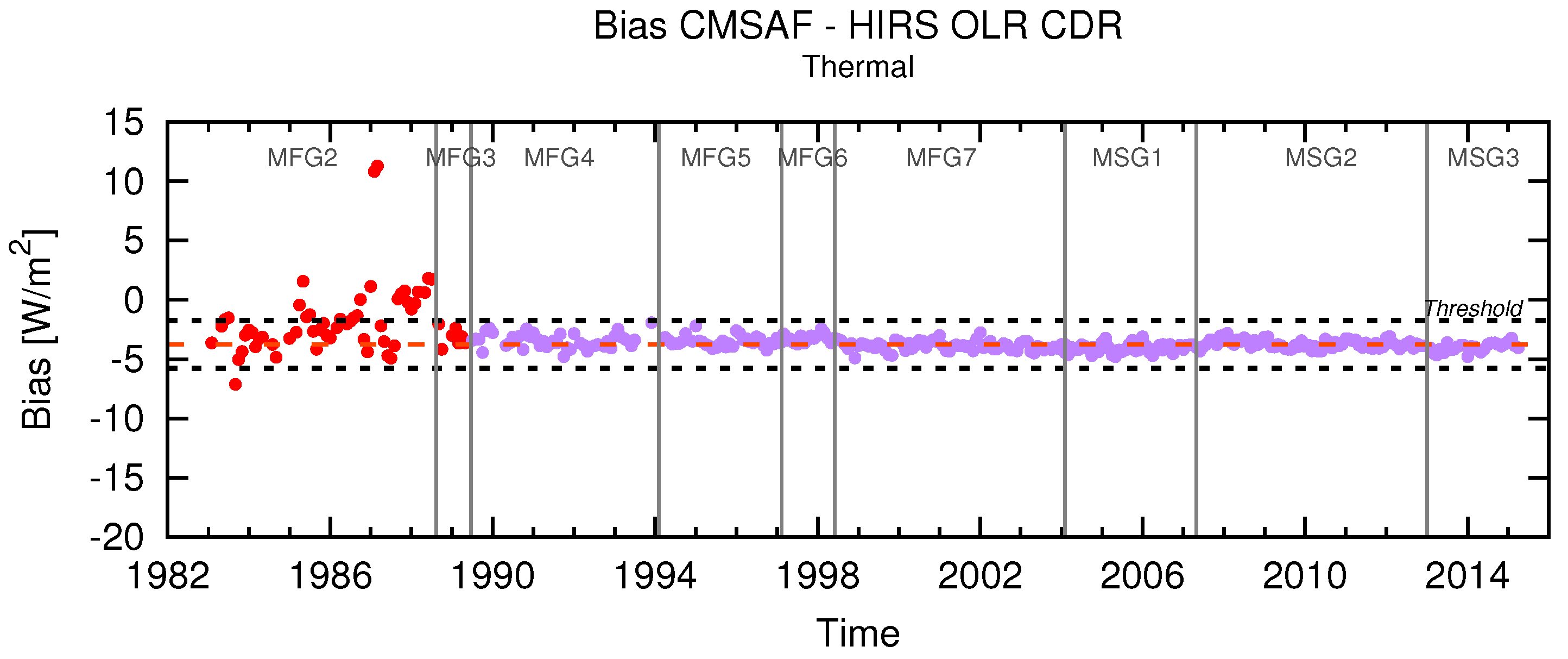
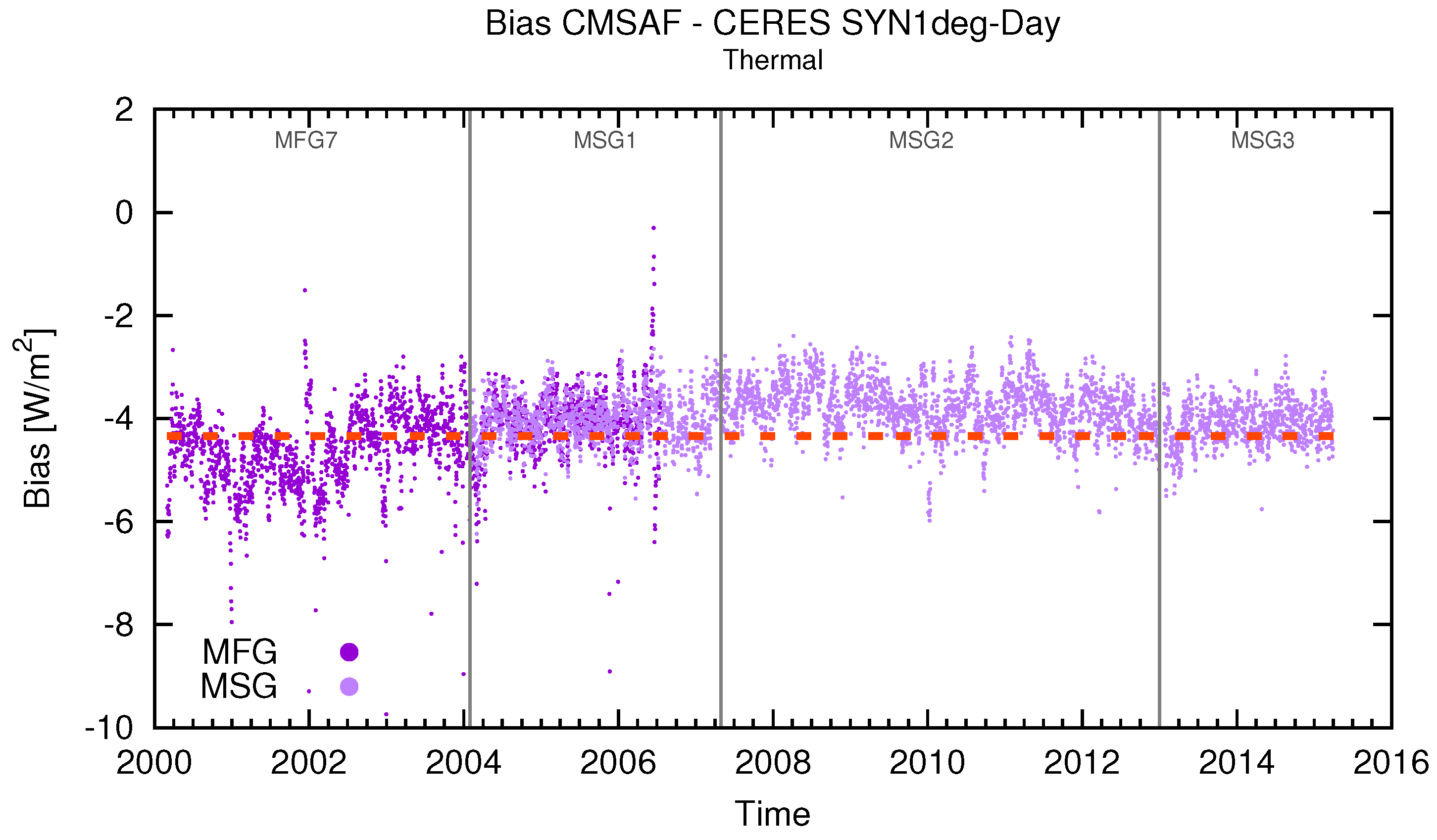
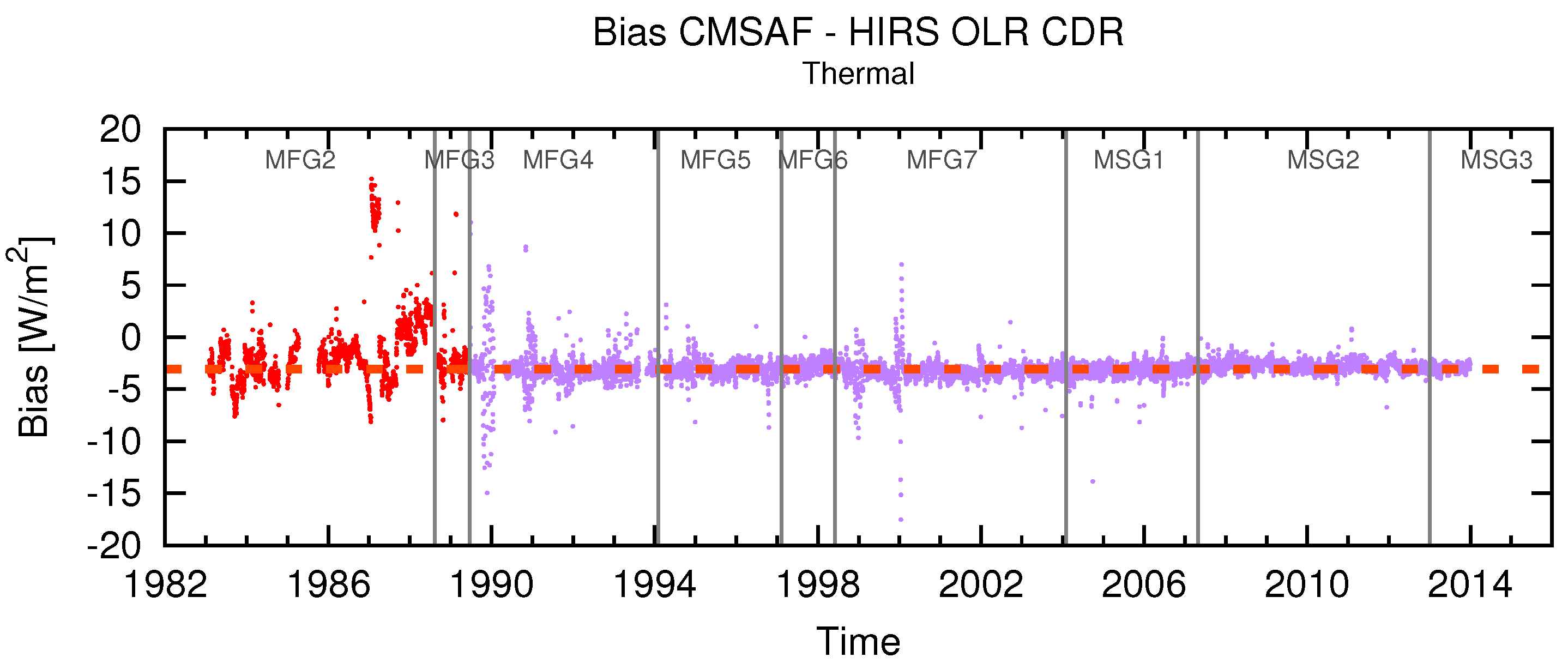
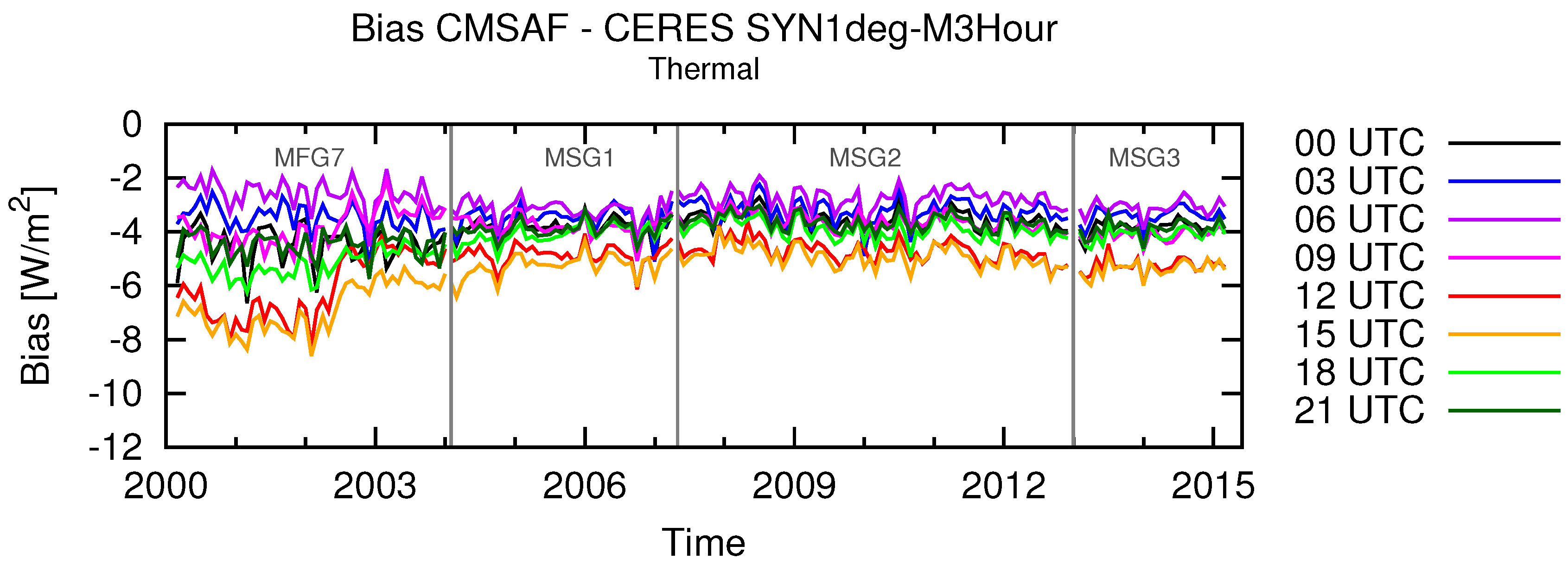


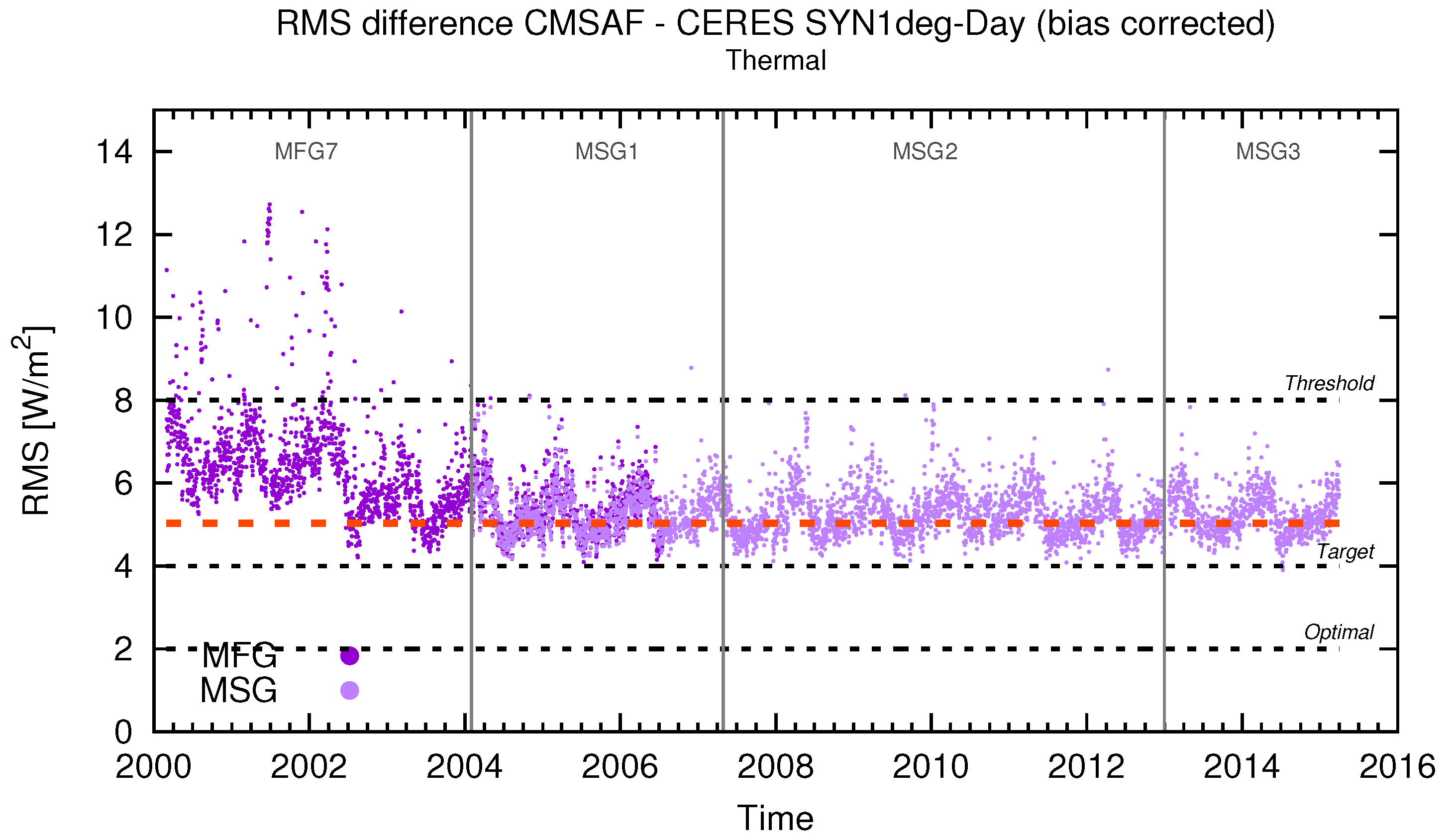


| Satellite | Launch Date | Used Data Period | Nominal Longitude | |
|---|---|---|---|---|
| MFG | Meteosat-1 (MFG-1) | 23/11/1977 | - | 0 |
| Meteosat-2 (MFG-2) | 19/06/1981 | 01/02/1983–11/08/1988 | 0 | |
| Meteosat-3 (MFG-3) | 15/06/1988 | 11/08/1988–19/06/1989 | 0 | |
| Meteosat-4 (MFG-4) | 06/03/1989 | 19/06/1989–04/02/1994 | 0 | |
| Meteosat-5 (MFG-5) | 02/03/1991 | 04/02/1994–13/02/1997 | 0 | |
| Meteosat-6 (MFG-6) | 19/11/1993 | 13/02/1997–03/06/1998 | 0 | |
| Meteosat-7 (MFG-7) | 02/09/1997 | 03/06/1998–31/01/2004 | 0 | |
| MSG | Meteosat-8 (MSG-1) | 28/08/2002 | 01/02/2004–30/04/2007 | 3.5 West |
| Meteosat-9 (MSG-2) | 21/12/2005 | 01/05/2007–31/12/2012 | 0 | |
| Meteosat-10 (MSG-3) | 05/07/2012 | 22/01/2013–30/04/2015 | 0 | |
| Meteosat-11 (MSG-4) | 15/07/2015 | - | 0 | |
| Products | Threshold | Target | Optimal |
|---|---|---|---|
| TRS MM | 4 Wm/decade | 0.6 Wm/decade | 0.3 Wm/decade |
| TET MM | 4 Wm/decade | 0.6 Wm/decade | 0.3 Wm/decade |
| Products | Threshold | Target | Optimal | |
|---|---|---|---|---|
| TRS | MM | 8 Wm | 4 Wm | 2 Wm |
| DM | 16 Wm | 8 Wm | 4 Wm | |
| MMDC | 16 Wm | 8 Wm | 4 Wm | |
| TET | MM | 4 Wm | 2 Wm | 1 Wm |
| DM | 8 Wm | 4 Wm | 2 Wm | |
| MMDC | 8 Wm | 4 Wm | 2 Wm | |
| Instrument | Solar Channels (TRS) | Thermal Channels (TET) |
|---|---|---|
| MVIRI | SEVIRI Solar Channel Calibration [15] | MFG-2 and -3: operational calibration |
| MFG-4 to -7: GSICS/EUMETSAT recalibration using HIRS (R. Stöckli and A. Tetzlaff, pers. comm.) | ||
| SEVIRI | KNMI SEVIRI recalibration [16] | EUMETSAT operational calibration (available in the prologue of the L1.5 Meteosat images) |
| Source | Version | Variable | Temporal | Spatial | Period | References |
|---|---|---|---|---|---|---|
| Resolution | Resolution | |||||
| CERES EBAF | 2.8 | TRS | MM | 1 × 1 | March 2000 | [33,34] |
| TET | onward | |||||
| CERES SYN1deg-Day | 3A | TRS | DM | 1 × 1 | March 2000 | [35,36] |
| TET | onward | |||||
| CERES SYN1deg-M3 Hour | 3A | TRS | MMDC | 1 × 1 | March 2000 | [35,36] |
| TET | (3-hourly) | onward | ||||
| HIRS OLR CDR | 2.7 1 | TET | MM | 2.5 × 2.5 | January 1979 | pers. comm. |
| Monthly | onward | H.-T. Lee | ||||
| HIRS OLR CDR | 1.2 | TET | DM | 1 × 1 | January 1979 to | [37,38] |
| Daily | December 2013 | |||||
| ERBS WFOV-CERES | 2 | TRS | MM | 0.7 × 0.7 | January 1985 to | [39,40,41] |
| (DEEP-C) | TET | May 2015 | ||||
| ISCCP FD | - | TRS | MM | 2.5 × 2.5 | July 1983 to | [42] |
| TET | MMDC | December 2004 |
| MM | DM | MMDC | ||||
|---|---|---|---|---|---|---|
| Error/Uncertainty | TRS | TET | TRS | TET | TRS | TET |
| Sources | (Midday) (R.3) | |||||
| Stability error | Stability of all the products better than 4 Wm (max-min) except for the TET during a given period in 1987 (MFG-2) (R.4) | |||||
| Processing error | 3.6 Wm | 2.6 Wm | 6.5 Wm | 4.2 Wm | 11.0 Wm | 3.5 Wm |
| (at 1 std. dev.) | ||||||
| Additional uncertainty due to missing input data | 0.3 Wm/day | 0.2 Wm/day | 0.5 Wm | 0.3 Wm | 0.7 Wm/day | 0.3 Wm/day |
| (R.1) (R.2) | ||||||
© 2017 by the authors. Licensee MDPI, Basel, Switzerland. This article is an open access article distributed under the terms and conditions of the Creative Commons Attribution (CC BY) license (http://creativecommons.org/licenses/by/4.0/).
Share and Cite
Urbain, M.; Clerbaux, N.; Ipe, A.; Tornow, F.; Hollmann, R.; Baudrez, E.; Velazquez Blazquez, A.; Moreels, J. The CM SAF TOA Radiation Data Record Using MVIRI and SEVIRI. Remote Sens. 2017, 9, 466. https://doi.org/10.3390/rs9050466
Urbain M, Clerbaux N, Ipe A, Tornow F, Hollmann R, Baudrez E, Velazquez Blazquez A, Moreels J. The CM SAF TOA Radiation Data Record Using MVIRI and SEVIRI. Remote Sensing. 2017; 9(5):466. https://doi.org/10.3390/rs9050466
Chicago/Turabian StyleUrbain, Manon, Nicolas Clerbaux, Alessandro Ipe, Florian Tornow, Rainer Hollmann, Edward Baudrez, Almudena Velazquez Blazquez, and Johan Moreels. 2017. "The CM SAF TOA Radiation Data Record Using MVIRI and SEVIRI" Remote Sensing 9, no. 5: 466. https://doi.org/10.3390/rs9050466






